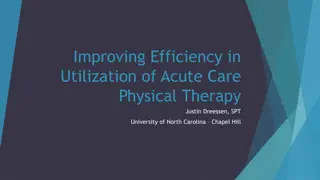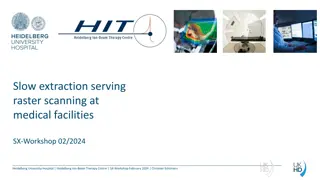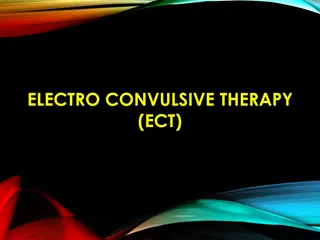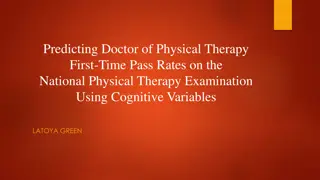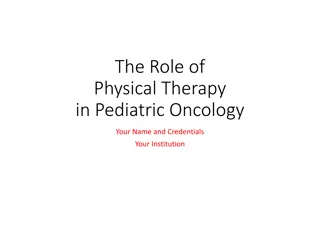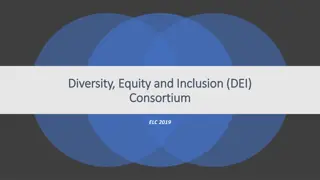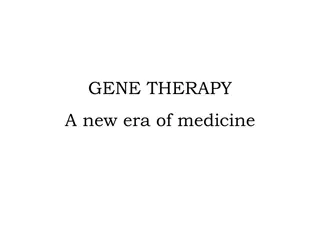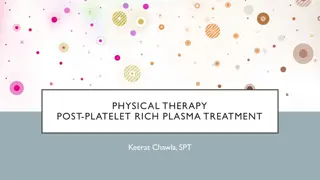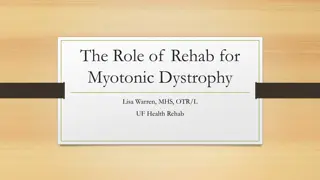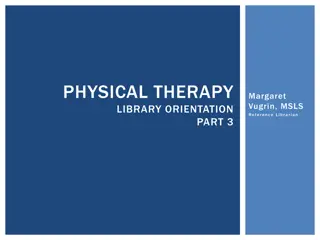Enhancing Physical Therapy Education: Strategic Framework Development
Cultivating a visionary and collaborative strategic framework is pivotal in shaping the future of physical therapy education. The process entails a review of key survey findings, background materials, and a set timeline. The aim is to establish a framework that will steer the evolution of physical therapy education towards excellence and innovation.
Download Presentation

Please find below an Image/Link to download the presentation.
The content on the website is provided AS IS for your information and personal use only. It may not be sold, licensed, or shared on other websites without obtaining consent from the author.If you encounter any issues during the download, it is possible that the publisher has removed the file from their server.
You are allowed to download the files provided on this website for personal or commercial use, subject to the condition that they are used lawfully. All files are the property of their respective owners.
The content on the website is provided AS IS for your information and personal use only. It may not be sold, licensed, or shared on other websites without obtaining consent from the author.
E N D
Presentation Transcript
PT Education Strategic Framework Key Survey Findings and Considerations
Process and Timeline to Develop Strategic Framework Develop a visionary and collaborative strategic framework that will guide the future of physical therapy education. Brief Review of Background Materials October Planning Sessions with the ELP November- December Immersion and Planning October Subgroup Work January-February Planning Session with the ELP to Finalize Framework March Subgroup to Advance Survey Draft April Electronic Survey with Stakeholder Community May-June Refine and Finalize Strategic Framework June-July 2
Response Statistics Survey Fielding The survey was fielded for 22 days. It launched May 21st, 2021 and closed on June 10th, 2021 Distribution Strategy APTA, and key partners distributed a generic survey link to physical therapy professionals and followed up with multiple reminder emails over the course of the survey fielding Total responses: 1,301 Complete: 851 Partial: 450 3
Demographics Which of the following best describes the type of facility or institution in which you currently do all or most of your work? If you work across multiple facilities or institutions, please select your primary work setting. (N = 1,156) Academic institution (postsecondary) Acute care hospital Hospital-based outpatient facility or clinic Private outpatient office or group practice Inpatient rehab facility (IRF) Patient s home/ home care Skilled Nursing Facility (SNF)/ Long-term care School system (preschool/primary/secondary) 36% 19% 16% 14% 3% 2% 1% 1% 1% 1% 0% Industry Research center Health and wellness facility Other 7% 4
Demographics Primary Professional Role (General) (N = 1,209) Physical Therapist (PT) 65% Academic administrator (i.e., program director) 14% Clinic owner or administrator 5% Physical Therapist Assistant (PTA) 4% Physical Therapist (PT) Student 2% Retired 2% Other 9% 5
Demographics Job Title or Specific Professional Role Select all that apply (N = 1,136) Primary (N = 1,079) 58% 39% Clinician 32% 18% Academic faculty/PT Program 11% 9% Director/academic coordinator of clin. ed./DPT program Site coordinator of clinical education Clinical administrator not described above 22% 7% 10% 6% 6% 4% Program director, DPT Program director, PTA 4% 3% 4% Academic administrator not described above Program director, residency Academic faculty/PTA Program Director/academic coordinator of clin. ed./PTA program Clinical faculty/DPT program Clinical faculty (mentor)/residency program Academic faculty/Fellowship Program Academic faculty/Residency Program Program coordinator, residency Clinical faculty (mentor)/fellowship program Program director, fellowship Clinical faculty/PTA program Program coordinator, fellowship 6% 6% 2% 11% 10% 3% 9% 3% 3% 1% 2% 0% 4% 8% Other 6
Demographics Please select the year in which you graduated from your entry-level PT/PTA degree program. Regrouped (N = 815) 28% 27% 25% 20% 2010 or after 2000-2009 1990-1999 Before 1990 7
Demographics Which of the following best describes your APTA membership status? (N = 1,189) Which of the following best describes the setting of your place of work? (N = 805) 82% 48% 38% 15% 14% 2% 1% I am currently a member of APTA I was a member of APTA in the past, but am not currently I have never been a member of APTA I am not eligible for APTA membership Urban Suburban Rural 8
Challenges and Trends Impacting PT Education 9
Common challenges related to student loan debt, time/ resource strains, limited salary growth and growth of PT programs What are the top trends and challenges you see impacting your institution? Select all that apply. (N = 1,097) 62% High student loan debt resulting from the high cost of education 56% Productivity strains such as lack of time and resources 51% Limited or restrictive growth in salaries 43% Growth of physical therapy programs and class sizes 39% Insurance and payment issues 38% Clinical site limitations and variability 31% Variance in the quality and training of educators 31% Lack of research/data to track student outcomes, etc. 24% Unwarranted variation in the performance of graduates and practitioners 24% Lack of collaboration between clinical and academic partners 19% Unwarranted variation in duration/structures of entry-level programs 10% Physical therapy program limitations and variability 10
Additional Challenges What other challenges, not listed above, do you see impacting physical therapy education? (n = 100, coded from a random sample of 413 open-ended responses) Cost of education, low compensation, debt Insufficient or inconsistent student education 17% 14% Lack of diversity 10% Education requirements (e.g., CAPTE 50/50 requirement) 8% Lack of qualified faculty Lack of programs/sites Oversaturated market Lack of collaboration Budget cuts and lack of funding Too many new programs Productivity expectations Competition with other professions Overemphasis on DEI Student entitlement and disrespect 7% 6% 6% 5% 4% 4% 3% 3% 3% 2% 2% COVID-19 Other Nothing or N/A 11% 8% 11
Vision for the Future of PT Education
Many stakeholders are not familiar with ELP and its ongoing work to advance the field How would you describe your familiarity with the ELP and its ongoing efforts to collaborate on opportunities to advance excellence in physical therapy education? (1,162) 31% 30% 27% 12% Not at all familiar with the ELP and its work Slightly familiar with the ELP and its work Moderately familiar with the ELP and its work Very familiar with the ELP and its work 13
Familiarity Segmented Familiarity with ELP by Primary Role % very or moderately familiar 67% 36% 28% 16% Physical Therapist (N = 760) Academic administrator (N = 159) Clinic owner or administrator (N = 57) Physical Therapist Assistant (N = 43) 14
Familiarity Segmented Familiarity with ELP by Job Title % very or moderately familiar 90% 82% 58% 46% 45% 31% 19% Clinician (N = 414) Academic faculty (PT program) (N = 193) Dir./Academic coordinator of clinical ed. (DPT program) (N = 92) Faculty, Program Dir., and Director of clin. ed. (PTA) (N = 78) Site coordinator of clinical ed. (N = 70) Other clinical admin. (N = 61) Program director (DPT) (N = 48) 15
There is strong alignment on the envisioned future for PT education Below is a proposed vision that articulates the ideal impact of physical therapy education in the future: Advancing excellence in physical therapy education across the learner continuum to meet societal health needs and optimize patient and public health outcomes. To what degree do you agree that the vision expresses the long-term impact that physical therapy education (and the broader physical therapy education stakeholder community) should strive to achieve? (N = 1,059) 52% 36% 9% 2% 1% Strongly disagree Somewhat disagree Neutral Somewhat agree Strongly agree 16
Adjustments to Vision How would you adjust the vision statement to better express the impact that physical therapy education should have in the long-term? Key Themes (N = 87 open-ended responses) Greater focus on the individual The primary role of physical therapy education should be to prepare students to become excellent clinicians so that they can help their patients. Once the students become excellent physical therapists, they have the ability to affect society It is not the role of physical therapy programs to meet societal health needs, it is the role of the individual therapist. Add definition and specificity Other suggestions This does not seem like a transformative, stretch vision How about: Empowering transformation in physical therapy education to achieve real change in the health of society. How would "advancing excellence" be assessed? It is not an objective measure. I don't think you can advance excellence if you have not defined what excellence is and how to measure it. PT education and vision should reflect 21st need for advanced, contemporary and affordable care. We provide direct patient care and rarely address issues at the population or public health level. The vision seems disingenuous and bound to fail. Advancing excellence in physical therapy education across various settings, and across the learner continuum, in order to meet the challenges of a dynamic, changing society, and optimize patient and public health outcomes in the midst of external variables in near-constant flux. The vision seems too broad and could apply to many other health professions, which results in the vision falling flat. No mention of the patient as a human, what about their psychosocial needs... it shouldn't be about outcomes, it should be about patient centered care and needs I believe the vision statement framework should have something that includes how it helps in the professional development of the individual/student. Question shown to those who somewhat/strongly disagree with proposed vision 17
Strategic Focus Areas 18
Areas for Exploration Competency Based Education: Transitioning to a competency-based education approach, where a learner does not move on until they demonstrate competence in a set of standard defined performance outcomes. It assumes a set of standard defined performance outcomes for any level of professional practice. Not all learners achieve the same outcomes within the same timeframe. CBE allows for individualized learning and optimizes the preparation of health professionals. Collaboration and Networks: Cultivate greater connection, knowledge-sharing and access to information among stakeholder groups and segments across physical therapy education to result in more effective decision making and continuous learning. Data Collection and Curation: The use of data and data analytics to drive decision-making and identify processes that promote improved learner development and outcomes. Infrastructure, Capacity and Development: Ensuring programs, clinics and education sites have the minimum resources in place to facilitate quality learning. Accessibility of Education/ Diversity, Equity and Inclusion: Ensuring physical therapy education remains viable, inclusive and welcoming to all individuals interested in pursuing a career in the field.
Competency Based Education
Competency-Based Education Below are potential positive outcomes that physical therapy education may reach within the next 5-20 years by shifting to a competency-based education approach. Please rate the importance of each outcome for the future. (N = 885) Very important Moderately important Slightly important Not at all important No opinion or N/A There is a defined set of standard performance outcomes across the learner continuum in physical therapy education 68% 26% 4% Educational research is used to inform the competency-based education approach in physical therapy 57% 34% 7% 2% Progression along the learner continuum occurs only when performance of the set of defined standard performance outcomes is demonstrated 50% 37% 8% Unwarranted variation among clinicians (entry-level through end of career) is reduced 42% 37% 14% 4% 3% Respondents were given the following instruction: Note, please rate each outcome individually rather than in relation to other 22 outcomes listed.
Competency-Based Education Importance of Outcomes by Primary Role % very important Physical Therapist Assistant (N = 29) Physical Therapist (N = 567) Academic administrator (N = 141) Clinic owner/ administrator (N = 42) There is a defined set of standard performance outcomes across the learner continuum in physical therapy education 67% 72% 60% 76% Progression along the learner continuum occurs only when performance of the set of defined standard performance outcomes is demonstrated 49% 45% 52% 45% Educational research is used to inform the competency- based education approach in physical therapy 53% 71% 59% 43% Unwarranted variation among clinicians (entry-level through end of career) is reduced 42% 32% 48% 45% Respondents were given the following instruction: Note, please rate each outcome individually rather than in relation to other 23 outcomes listed.
Competency-Based Education Importance of Outcomes by Job Title % very important Faculty, Program Dir., and Director of clin. ed. (PTA) (N = 63) Dir./ Site Academic faculty (PT program) (N = 168) Academic coordinator of clinical ed. (DPT) (N = 75) Other clinical admin. (N = 45) Program director (DPT) (N = 41) coordinator of clinical ed. (N = 57) Clinician (N = 291) There is a defined set of standard performance outcomes across the learner continuum in physical therapy education 63% 64% 72% 78% 79% 60% 68% Progression along the learner continuum occurs only when performance of the set of defined standard performance outcomes is demonstrated 47% 46% 49% 51% 65% 58% 38% Educational research is used to inform the competency-based education approach in physical therapy 47% 60% 65% 55% 59% 49% 74% Unwarranted variation among clinicians (entry- level through end of career) is reduced 40% 43% 28% 33% 49% 53% 29% Respondents were given the following instruction: Note, please rate each outcome individually rather than in relation to other 24 outcomes listed.
Competency-Based Education Are there any additional outcomes or benefits, not listed above, that would be important to achieve as a result of transitioning to a competency-based education approach? Key Themes(N = 153 open-ended responses) Consider risks of over- standardizing Variability is unavoidable and not always negative Concerns about implementation Concerns about cost There is variation and there will always be variation with human beings. Time to move past that excuse and instead focus on the dynamic nature of evolving clinical guidelines. I worry about this "standard set of performance outcomes." Practice acts are different in every state and PT practice is quite different, appropriately, based on setting, geographic location, etc. I am not necessarily opposed to this, but have significant concerns about implementation. The cost of a physical therapy education needs to decrease. However, with this model of learning it seems costs would only continue to increase in order to have enough academic staff to meet students at their individual level of progression. Competency-based approach could feel like pass/fail which sometimes results in the lowest acceptable performance as the students goal Some variation is needed in order to provide patient centered care. The profession s emphasis on limiting variability could have negative consequences if not framed in the appropriate manner. Maintaining individualized education that helps to progress professionals but also does not remove the importance of peer- based learning and peer support by isolating and degrading individuals who may not fall perfectly in the mass standardized performance outcomes. We must also consider how we can support CBE without increasing educational cost. I work with competencies often in my role. The issue becomes consistency among the competency validators. There are multiple methods of competency validation; choice of method and validator training becomes a huge issue. There will always be at least some variation between and entry level vs an end of career therapist because of ongoing learning and growth 25
Collaboration and Networks
Collaboration and Networks Below are potential positive outcomes that may be achieved over the next 5-20 years by enhancing collaboration and networks across PT education, including but not limited to partnerships between clinical and academic communities. (N = 888) Very important Moderately important Slightly important Not at all important No opinion or N/A Clinical and academic partnerships support the provision of learning and delivery of patient/client-centered care 78% 18% 2% Clinical and academic partners have clear roles and responsibilities, including a shared obligation to learner development that will result in optimal outcomes to ensure learner readiness to meet performance expectations Clinical and academic stakeholders in all settings participate in open and inclusive partnerships that leverage communication structures to ensure access to adequate and appropriate infrastructure (i.e., resources, research, systems, 70% 25% 4% 54% 35% 7% 3% An engaged community of education researchers that collaborates and shares knowledge that advances education research in physical therapy 50% 40% 8% An engaged community of education researchers that offers professional support through training, career resources, grant writing support, mentorship, and more 45% 42% 11% A universally accepted, placement management system (that is NOT a matching system) that meets the needs of stakeholders and students while maximizing grassroots partnerships will increase efficiencies in clinical education Respondents were given the following instruction: Note, please rate each outcome individually rather than in relation to other outcomes listed. 34% 33% 21% 7% 6% 27
Collaboration and Networks Importance of Outcomes by Primary Role % very important Physical Therapist Assistant (N = 27) Physical Therapist (N = 571) Academic administrator (N = 142) Clinic owner or administrator (N = 43) Clinical and academic partnerships support the provision of learning and delivery of patient/client-centered care 76% 81% 77% 81% Clinical and academic partners have clear roles and responsibilities 69% 68% 77% 63% Clinical and academic stakeholders in all settings participate in open and inclusive partnerships that leverage communication structures 52% 57% 57% 41% An engaged community of education researchers that collaborates and shares knowledge that advances education research in physical therapy 48% 51% 47% 33% An engaged community of education researchers that offers professional support 43% 46% 34% 35% A universally accepted, placement management system will increase efficiencies in clinical education 31% 34% 35% 41% 28
Collaboration and Networks Importance of Outcomes by Facility/Institution % very important Hospital-based outpatient facility or clinic (N = 128) Private outpatient office or group practice (N = 110) Academic institution (postsecondary) (N = 356) Acute care hospital (N = 161) Clinical and academic partnerships support the provision of learning and delivery of patient/client-centered care 79% 77% 68% 83% Clinical and academic partners have clear roles and responsibilities 77% 70% 65% 70% Clinical and academic stakeholders in all settings participate in open and inclusive partnerships that leverage communication structures An engaged community of education researchers that collaborates and shares knowledge that advances education research in physical therapy 59% 48% 55% 55% 48% 45% 46% 52% An engaged community of education researchers that offers professional support 48% 41% 45% 45% A universally accepted, placement management system will increase efficiencies in clinical education 41% 30% 37% 32% 29
Collaboration and Networks Are there any additional outcomes or benefits, not listed above, that would be important to achieve as a result of focusing on facilitating collaboration and networks across physical therapy education? Key Themes (N = 126 open-ended responses) Collaboration between clinical and academic communities is critical Need for monetary incentive Concerns about implementation Thoughts on a matching system In private practices many clinicians will want to participate, but clinicians deserve to be compensated for their time. We shouldn't be expected to continually volunteer. Engaging the clinical sites is crucial. We need a structured way for the academic side to reach out to, and develop, the clinical education leadership side and their management. Academic programs continuing to support clinical sites but also recognizing subject matter experts may live in the clinical environment and not the academic setting There needs to be stronger ties between clinical sites and universities. We can't continue on this "volunteer" system It has already broken down and will again. I think the theory of these statements sounds good, but this does not reflect reality. Top- down attempts at overhauling clin ed only tend to penalize small schools A matching system, while likely to be unpopular, may be necessary to maximize our limited resources of clinical sites. I strongly believe a "matching" system IS drastically needed and appropriate. Clinicians and their employers take the risks associated with taking on students without any monetary incentive The model of forcing clinical practices and acute care hospitals to provide observation hrs., undergraduate visits and affiliations without any monetary incentive will likely eventually fail. Part of the vision forward must include a model that has a university funded clinical program. I do not really know how you can get a few hundred clinical sites - 2 dozen programs per state - to all be on the same page. A placement management system is only needed for large metropolitan areas where academic settings want to keep their students in a small radius from the academic setting. Smaller rural universities do not need it as there are ample sites for these types of programs. Realizing corporate level limitations on hospitals in the network that direct student placement in clinical settings that are beyond the physical therapy departments 30
Data Collection and Curation
Data Collection and Curation Below are potential positive outcomes that physical therapy education may reach over the next 5-20 years by enhancing efforts around data collection and curation. Please rate the importance of each outcome for the future. (N = 891) Very important Moderately important Slightly important Not at all important No opinion or N/A Research studies that identify, benchmark and explore key workforce issues are accessible to guide decision making on issues including but not limited to student debt, DEI, program costs and workforce demographics 55% 35% 9% Availability of data will result in wide dissemination of information across the learner continuum (i.e., enhanced knowledge-sharing on key areas ranging from learner outcomes, to clinical education outcomes, to program resources, student support, etc.) 47% 41% 9% 3% A comprehensive collection of data (e.g., data warehouse/lake), and analyses of those data will drive decision making and practice in physical therapy education along the learner continuum 43% 45% 10% Key information and data are available to the general public and other relevant external groups to promote data-driven decision making and improved patient care 41% 42% 13% Respondents were given the following instruction: Note, please rate each outcome individually rather than in relation to other 32 outcomes listed.
Data Collection and Curation Importance of Outcomes by Primary Role % very important Physical Therapist Assistant (N = 28) Physical Therapist (N = 566) Academic administrator (N = 142) Clinic owner or administrator (N = 46) Research studies that identify, benchmark and explore key workforce issues are accessible to guide decision making 51% 58% 60% 52% Availability of data will result in wide dissemination of information across the learner continuum 45% 49% 61% 43% A comprehensive collection of data, and analyses of those data will drive decision making and practice in physical therapy education along the learner continuum Key information and data are available to the general public and other relevant external groups to promote data-driven decision making and improved patient care 40% 47% 50% 43% 40% 42% 47% 43% 33
Data Collection and Curation Importance of Outcomes by Job Title % very important Dir./ Faculty, Program Dir., and Director of clin. ed. (PTA) (N = 64) Academic coordinator of clinical ed. (DPT program) (N = 76) Site Academic faculty (PT program) (N = 169) Other clinical admin. (N = 48) Program director, DPT (N = 42) coordinator of clinical ed. (N = 57) Clinician (N = 290) Research studies that identify, benchmark and explore key workforce issues are accessible to guide decision making Availability of data will result in wide dissemination of information across the learner continuum A comprehensive collection of data, and analyses of those data will drive decision making and practice in physical therapy education along the learner continuum Key information and data are available to the general public and other relevant external groups to promote data-driven decision making and improved patient care 47% 59% 64% 48% 48% 53% 60% 43% 44% 56% 41% 61% 50% 43% 35% 46% 47% 34% 53% 40% 50% 37% 45% 42% 39% 44% 36% 46% 34
Data Collection and Curation Importance of Outcomes by Work Setting % very important Urban (N = 382) Suburban (N = 303) Rural (N = 112) Research studies that identify, benchmark and explore key workforce issues are accessible to guide decision making 57% 54% 41% Availability of data will result in wide dissemination of information across the learner continuum 49% 45% 42% A comprehensive collection of data, and analyses of those data will drive decision making and practice in physical therapy education along the learner continuum Key information and data are available to the general public and other relevant external groups to promote data-driven decision making and improved patient care 46% 39% 38% 40% 39% 46% 35
Data Collection and Curation Importance of Outcomes by Practice Ownership % very important Practice owner (N = 58) Not practice owner (N = 752) Research studies that identify, benchmark and explore key workforce issues are accessible to guide decision making 63% 53% Availability of data will result in wide dissemination of information across the learner continuum 41% 46% A comprehensive collection of data, and analyses of those data will drive decision making and practice in physical therapy education along the learner continuum 50% 41% Key information and data are available to the general public and other relevant external groups to promote data-driven decision making and improved patient care 53% 39% 36
Data Collection and Curation What types of information, data or benchmarks would be valuable to access to help support improved learner development and outcomes? Key Themes (N = 259 open-ended responses) Data on patient and student outcomes Data on salaries, student loans, debt, etc. Data on diversity and equity Students need to understand the salary ranges and job availability in the geographic areas they intend to practice so they understand the debt ratio they will be incurring. Identify barriers for underrepresented minorities for access and completion of DPT programs. Qualitative measures for inclusivity for cultural diversity within DPT programs. I wish there were a way to assess the quality of the clinical experience in terms of the outcome of the new professional. I would like to see that information used to feed back to clinical sites to rate their effectiveness, and provide roadmaps to improvement. What are average PT salaries 5 years out from graduation for those who completed residencies during that time vs. those who did not? What, if any, is the difference in income/career advancement opportunities for those with clinical specialist certification? Data on admission and performance of students of color and those from other diverse backgrounds. Link quality factors in physical therapy education to client/community/population outcomes. What truly is the impact of our education down stream? Knowing what areas are the greatest concern and/or need in a given community, diagnostic group, age, etc. Knowing the impact of student debt and lack of DEI on individuals and communities. Would love to be able to see how academic preparation contributes to excellence in patient care, both during clinical education experiences and post-graduation. How are patient outcomes impacted by the curriculum? Impact of insurance reimbursement expected on learner performance in a clinical institution Student income/debt ratio 37
Infrastructure, Capacity and Development
Infrastructure, Capacity and Development Below are potential positive outcomes that physical therapy education may reach over the next 5-20 years by focusing on enhancing infrastructure, capacity and development. Please rate the importance of each outcome for the future. (N = 898) Very important Moderately important Slightly important Not at all important No opinion or N/A Faculty demonstrate necessary qualifications to deliver evidence- based educational and practice aspects of curricula across the learning continuum 77% 20% 3% Students have access to support and resources needed to facilitate learning and address any issues that arise 76% 20% 3% Education programs meet a common set of expected benchmarks that ensure all programs have the faculty development in place to deliver high-quality education to learners 74% 20% 5% Education programs meet a common set of expected benchmarks that ensure all programs have the student supports in place to deliver high-quality education to learners 70% 24% 5% Respondents were given the following instruction: Note, please rate each outcome individually rather than in relation to other 39 outcomes listed.
Infrastructure, Capacity and Development Below are potential positive outcomes that physical therapy education may reach over the next 5-20 years by focusing on enhancing infrastructure, capacity and development. Please rate the importance of each outcome for the future. (Cont d) (N = 898) Very important Moderately important Slightly important Not at all important No opinion or N/A Education programs meet a common set of expected benchmarks that ensure all programs have the finances and resources in place to deliver high-quality education to learners 63% 29% 6% Faculty demonstrate necessary qualifications to perform in leadership or mentorship roles 56% 35% 7% Academic programs individually and collectively produce high quality evidence that informs the foundational science, clinical practice, heath care systems, and educational practices in physical therapy 50% 38% 9% 2% Faculty demonstrate necessary qualifications to conduct research 26% 45% 21% 5% 2% Respondents were given the following instruction: Note, please rate each outcome individually rather than in relation to other 40 outcomes listed.
Infrastructure, Capacity and Development Importance of Outcomes by Facility/Institution % very important Hospital-based outpatient facility or clinic (N = 132) Private Academic institution (postsecondary) (N = 360) Acute care hospital (N = 165) outpatient office or group practice (N = 113) Faculty demonstrate necessary qualifications to deliver evidence-based educational and practice aspects of curricula across the learning continuum Students have access to support and resources needed to facilitate learning and address any issues that arise Education programs meet a common set of expected benchmarks that ensure all programs have the faculty development in place to deliver high- quality education Education programs have the student supports in place to deliver high- quality education Education programs have the finances and resources in place to deliver high-quality education Faculty demonstrate necessary qualifications to perform in leadership or mentorship roles Academic programs produce high quality evidence that informs the foundational science, clinical practice, heath care systems, and educational practices in physical therapy Faculty demonstrate necessary qualifications to conduct research 83% 78% 64% 75% 82% 76% 64% 75% 77% 69% 67% 76% 70% 69% 63% 73% 65% 56% 58% 66% 70% 61% 52% 48% 54% 56% 46% 47% 30% 28% 27% 24% 41
Infrastructure, Capacity and Development Are there any additional outcomes or benefits, not listed above, that would be important to achieve as a result of focusing on enhancing infrastructure, capacity and development? Key Themes (N = 133 open-ended responses) Teacher quality and requirements Faculty relationship with research Operational considerations Clinical emphasis Faculty in Medical curricula do not need to be PhDs, they are MDs. Why are we demanding PT faculty achieve a higher level of academic education? I do NOT believe that all faculty need to conduct research. Some of us should continue to do a fantastic job teaching and mentoring students without the burden of doing research that they are poorly trained to perform. Clinical faculty are extremely important for clinical programs and all programs should have full time and fully invested clinical faculty, not just research faculty There should be a minimum number of faculty per student As programs grow and clinical site availability stretches to try to meet these needs, site payment to accept students should be considered as there is an institutional cost (labor, supplies, productivity, time) to supporting clinical education at a facility level. Faculty benchmarks should focus more on teaching and clinical competence than research competence in entry-level programs. I think it is difficult to be 100% committed to both research and teaching. Our profession might benefit from not requiring the researchers to teach in addition to their research role. Education programs produce clinical professionals able to deliver predictable patient outcomes in a sustainable manner while working at the top of their license. We must make sure faculty are qualified. There is too much complaining about the advanced terminal degree but without that the outcome measures and research will not advance. I do not support framing the role and responsibility of academic programs as one that fully has to carry the burden of doing research. The role of academic programs is EDUCATION and APPLICATION of research to practice and education itself. Benchmarks for finance needs to be established and its own line-item so that programs are empowered to facilitate changes within their own institution and prevent tuition / fee raises Faculty have the opportunity to continue to continue with clinical practice so they maintain real world experience. Faculty need to demonstrate they have educational training in "how to teach". 42
Accessibility of Education / Diversity, Equity and Inclusion
Accessibility of Education / Diversity, Equity and Inclusion Below are potential positive outcomes that physical therapy education may reach over the next 5-20 years by focusing on accessibility of education/ diversity, equity and inclusion. Please rate the importance of each outcome for the future. (N = 887) Very important Moderately important Slightly important Not at all important No opinion or N/A As it relates to program enrollment, there is ongoing advocacy for both sustainable reimbursement as well as appropriate compensation levels across the profession 72% 21% 4% Those considering professional/technical (entry-level) physical therapy education will have access to career resources and advising that support: an understanding of the full cost of that education; financial aid availability; salary expectations or impact Academic and clinical educators will actively support inclusive environments in their programming through facilitation of an understanding of the benefits of a diverse team as well as the barriers created by overt and implicit biases 69% 25% 4% 63% 24% 8% Diversity in physical therapy education reflects the many dimensions of individual differences represented in communities and society 62% 26% 8% 44
Accessibility of Education / Diversity, Equity and Inclusion Below are potential positive outcomes that physical therapy education may reach over the next 5-20 years by focusing on accessibility of education/ diversity, equity and inclusion. Please rate the importance of each outcome for the future. (Cont d) (N = 887) Very important Moderately important Slightly important Not at all important No opinion or N/A Those considering post-professional/post-technical physical therapy education will have access to career resources and advising that support: an understanding of the full cost of that education; financial aid availability; salary expectations or impact; Those considering post-professional/post-technical physical therapy education will have access to career resources and advising that support: an understanding of the full cost of that education; financial aid availability; salary expectations or impact; fi financial literacy; and management of an individual s resources 58% 31% 9% There is shared commitment to advancing DEI across the physical therapy learner continuum as evidenced by targeted recruitment strategies, increased accessibility of admissions/application processes, and financial structures to support professional educati education for diverse individuals There is shared commitment to advancing DEI across the physical therapy learner continuum as evidenced by targeted recruitment strategies, increased accessibility of admissions/application processes, and financial structures to support professional 56% 28% 12% 3% Educators/faculty and education programs/clinical sites participate in pipeline development by increasing awareness of physical therapy as a career option from early education onward, with particular focus on the unique recruitment needs of those from unde those from underserved, underrepresented or marginalized populations Educators/faculty and education programs/clinical sites participate in pipeline development by increasing awareness of physical therapy as a career option from early education onward, with particular focus on the unique recruitment needs of 53% 31% 13% 2% Education research and data analytics related to diversity, equity and inclusion will inform best-practices in physical therapy education inform best-practices in physical therapy education Education research and data analytics related to diversity, equity and inclusion will 45% 37% 13% 3% 45
Accessibility of Education / Diversity, Equity and Inclusion Importance of Outcomes by Primary Role % very important Physical Therapist (N = 567) Academic administrator (N = 142) Clinic owner or admin. (N = 45) Physical Therapist Assistant (N = 29) As it relates to program enrollment, there is ongoing advocacy for both sustainable reimbursement as well as appropriate compensation levels across the profession Those considering professional physical therapy education will have access to career resources and advising Academic and clinical educators will actively support inclusive environments in their programming Diversity in physical therapy education reflects the many dimensions of individual differences represented in communities and society Those considering post-professional physical therapy education will have access to career resources and advising There is shared commitment to advancing diversity, equity and inclusion across the physical therapy learner continuum Educators/faculty and education programs/clinical sites participate in pipeline development by increasing awareness of physical therapy as a career option from early education onward Education research and data analytics related to diversity, equity and inclusion will inform best-practices in physical therapy education 75% 70% 70% 59% 68% 70% 80% 76% 62% 72% 56% 62% 60% 70% 56% 61% 59% 47% 67% 71% 53% 67% 50% 52% 49% 63% 58% 55% 43% 49% 45% 31% 46
Accessibility of Education / Diversity, Equity and Inclusion Importance of Outcomes by Title % very important Dir./ Faculty, Program Dir., and Director of clin. ed. (PTA) (N = 66) Site Academic faculty (PT) (N = 168) Academic coordinator of clinical ed. (DPT) (N = 76) Other clinical admin. (N = 47) Program director (DPT) (N = 43) coordinator of clinical ed. (N = 58) Clinician (N = 290) As it relates to program enrollment, there is ongoing advocacy for both sustainable reimbursement as well as appropriate compensation levels across the profession Those considering professional physical therapy education will have access to career resources and advising Academic and clinical educators will actively support inclusive environments in their programming Diversity in physical therapy education reflects the many dimensions of individual differences represented in communities and society Those considering post-professional physical therapy education will have access to career resources and advising There is shared commitment to advancing diversity, equity and inclusion across the physical therapy learner continuum Educators/faculty and education programs/clinical sites participate in pipeline development by increasing awareness of physical therapy as a career option from early education onward Education research and data analytics related to diversity, equity and inclusion will inform best-practices in physical therapy education 73% 74% 69% 74% 79% 70% 71% 69% 62% 66% 76% 71% 81% 63% 56% 68% 73% 61% 70% 49% 78% 57% 67% 66% 57% 71% 51% 70% 63% 51% 45% 55% 59% 65% 38% 47% 62% 58% 48% 60% 54% 74% 45% 59% 61% 55% 56% 45% 70% 37% 51% 49% 33% 55% 43% 53% 47
Accessibility of Education / Diversity, Equity and Inclusion Importance of Outcomes by Work Setting % very important Urban (N = 384) Suburban (N = 307) Rural (N = 111) As it relates to program enrollment, there is ongoing advocacy for both sustainable reimbursement as well as appropriate compensation levels across the profession Those considering professional physical therapy education will have access to career resources and advising Academic and clinical educators will actively support inclusive environments in their programming Diversity in physical therapy education reflects the many dimensions of individual differences represented in communities and society Those considering post-professional physical therapy education will have access to career resources and advising There is shared commitment to advancing diversity, equity and inclusion across the physical therapy learner continuum Educators/faculty and education programs/clinical sites participate in pipeline development by increasing awareness of physical therapy as a career option from early education onward Education research and data analytics related to diversity, equity and inclusion will inform best-practices in physical therapy education 71% 77% 70% 70% 70% 68% 65% 66% 55% 66% 63% 47% 54% 63% 55% 57% 60% 43% 55% 54% 51% 49% 44% 33% 48
Accessibility of Education / Diversity, Equity and Inclusion Are there any additional outcomes or benefits, not listed above, that would be important to achieve as a result of focusing on accessibility of education/ diversity, equity and inclusion? Key Themes (N = 123 open-ended responses) Financial support and resources Education, training, and resources related to DEI Prioritize quality and excellence Diversity helps students and underserved communities Need for those seeking to enter the profession to understand the financial ramifications of their decision as it relates to high student loan debt and limited potential for salary growth in the profession. Programs should make a concerted effort to diversify academic faculty This has already been shown to improve not only the diversity of the applicant pool but also retention, successful completion, and lifelong mentorship relationships. While having a diverse workforce is important, we also can't lose track of the fact that we need to prepare ALL PT/PTA students to be culturally competent and able to work effectively with all people. Selection of the best candidates from a broadened pool of candidates can be achieved without regard for filling some quota What is needed for providing the best outcomes for patients, the community, and public health needs is selection of the best candidates for our schools. It's all well and good to provide students with information on financial aid and financial literacy, but that still means many students come out of a PT education with nearly a quarter or a million dollars in debt. Students clinical experiences should also take into account various socioeconomic settings and how this can impact an individual's access and choices for healthcare. Diminished health disparities should be a benefit from improved diversity within the field. Patients from diverse populations or underrepresented groups will be more likely to seek out PT services if they can see themselves in the diversity of the providers. Please do not reduce the high entry standards and pre professional experiences to meet a societal expectation for DEI if the high standards aren't able to be met. Mentorship of minority program directors Need based scholarships and a mechanism for assessing need Advancing diversity means having clinics in disadvantaged areas, providing care and pro bono services to diverse populations. Ensure a physical therapy career is lucrative enough to repay student loans and that an individual can afford housing, transport, food, etc. 49




